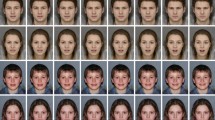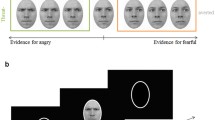Abstract
Several studies suggest that children with ADHD tend to perform worse than typically developing children on emotion recognition tasks. However, most of these studies have focused on the recognition of facial expression, while there is evidence that context plays a major role on emotion perception. This study aims at further investigating emotion processing in children with ADHD, by assessing not only facial emotion recognition (Experiment 1) but also emotion recognition on the basis of contextual cues (Experiment 2). Twenty-seven children and adolescents with ADHD were compared to age-matched typically developing controls. Importantly, findings of this study show that emotion-processing difficulties in children with ADHD extend beyond facial emotion and also affect the recognition of emotions on the basis of contextual information. Our data thus indicate that children with ADHD have an overall emotion-processing deficit.
Similar content being viewed by others
References
Barkley RA (1990) Attention–deficit hyperactivity disorder: a handbook for diagnosis and treatment. Guilford Press, New York
Barkley RA (1997) Behavioral inhibition, sustained attention and executive functions: constructing and unifying theory of ADHD. Psychol Bull 121(1):65–94. doi:10.1037/0033-2909.121.1.65
Biederman J, Faraone S, Milberger S, Guite J, Mick E, Chen L et al (1996) A prospective 4-year follow-up study of attention-deficit hyperactivity and related disorders. Arch Gen Psychiatry 53(5):437–446
Landau S, Milich R (1988) Social communication patterns of attention-deficit-disorder boys. J Abnorm Child Psychol 16(1):69–81. doi:10.1007/BF00910501
Greene RW, Biederman J, Faraone SV, Monuteaux MC, Mick E, DuPre EP et al (2001) Social impairment in girls with ADHD: patterns, gender comparisons, and correlates. J Am Acad Child Adolesc Psychiatry 40(6):704–710. doi:10.1097/00004583-200106000-00016
Whalen CK, Henker B (1992) The social profile of attention-deficit hyperactivity disorder: five fundamental facets. Child Adolesc Psychiatr Clin N Am 1:395–410
Hinshaw SP (1992) Intervention for social competence and social skill. Child Adolesc Psychiatr Clin N Am 1:539–552
Kinsbourne M, Bemporad B (1984) Lateralization of emotion: a model and the evidence. In: Fox NA, Davidson RJ (eds) The psychobiology of affective development. Erbaum, Hillsdale, NJ, pp 259–291
Hobson RP (1991) Methodological issues for experiments on autistic individuals’ perception and understanding of emotion. J Child Psychol Psychiatry 12:1135–1158. doi:10.1111/j.1469-7610.1991.tb00354.x
Lindner JL, Rosen LA (2006) Decoding of emotion through facial expression, prosody and verbal content in children and adolescents with Asperger’s syndrome. J Autism Dev Disord 36:769–777. doi:10.1007/s10803-006-0105-2
Cadesky EB, Mota VL, Schachar RJ (2000) Beyond words: how do children with ADHD and/or conduct problems process nonverbal information about affect? J Am Acad Child Adolesc Psychiatry 39(9):1160–1167. doi:10.1097/00004583-200009000-00016
Singh SD (1998) Recognition of facial expressions of emotion by children with attention-deficit hyperactivity disorder. Behav Modif 22(2):128–142. doi:10.1177/01454455980222002
Yuill N, Lyon J (2007) Selective difficulty in recognising facial expressions of emotion in boys with ADHD: general performance impairments or specific problems in social cognition? Eur Child Adolesc Psychiatry 16(6):398–404. doi:10.1007/s00787-007-0612-5
Casey RJ (1996) Emotional competence in children with externalizing and internalizing disorders. In: Lewis M, Sullivan M (eds) Emotional development in atypical children. Erlbaum, Hillsdale, NJ, pp 161–183
Corbett B, Glidden H (2000) Processing affective stimuli in children with attention-deficit hyperactivity disorder. Child Neuropsychol 6(2):144–155. doi:10.1076/chin.6.2.144.7056
Katz-gold I, Besser A, Priel B (2007) The role of simple emotion recognition skills among school aged boys at risk of ADHD. J Abnorm Child Psychol 35:363–378. doi:10.1007/s10802-006-9096-x
Carroll JM, Russell JA (1996) Do facial expressions signal specific emotions? Judging emotion from the face in context. J Pers Soc Psychol 70(2):205–218. doi:10.1037/0022-3514.70.2.205
Kolb B, Wilson B, Taylor L (1992) Developmental changes in the recognition and the comprehension of facial expression: implications for frontal lobe function. Brain Cogn 20:74–84. doi:10.1016/0278-2626(92)90062-Q
Barrett LF, Lindquist KA, Gendron M (2007) Language as context for the perception of emotion. Trends Cogn Sci 11(8):327–332. doi:10.1016/j.tics.2007.06.003
American Psychiatric Association (1994) Diagnostic and statistical manual of mental disorders, 4th edn. American Psychiatric Association, Washington, DC
Kaufman J, Birmaher B, Brent D, Rao U, Ryan N (1997) Schedule for affective disorders and schizophrenia for school-age children-Present and Lifetime Version (K-SADS-PL): initial reliability and validity data. J Am Acad Child Adolesc Psychiatry 36(7):980–988. doi:10.1097/00004583-199707000-00021
Conners CK (1997) Conners’ rating scales-revised: technical manual. Multi-Health Systems Inc, New␣York
Weschler D (1991) Manual for the Weschler intelligence scale for children (WISC-III), 3rd edn. Psychological Corporation, New York
Santos A, Rondan R, Milne D, Deruelle C (2008) Social relevance boosts context processing in Williams syndrome. Dev Neuropsychol 33(4):1–12. doi:10.1080/87565640802111598
Da Fonseca D, Santos A, Bastard-Rosset D, Rondan C, Poinso F, Deruelle C (in press) Can Children with autistic spectrum disorders extract emotions out of contextual cues? Res Autism Spectr Disord. doi:10.1016/j.rasd.2008.04.001
Rapport LJ, Friedman SL, Tzelepis A, Von Voorhis A (2002) Experienced emotion and affect recognition in adult attention-deficit hyperactivity disorder. Neuropsychology 16(1):102–110. doi:10.1037/0894-4105.16.1.102
Baron-Cohen S, Tager-Flusberg H, Cohen DJ (1993) Understanding other minds. Perspectives from autism. University Press, Oxford
Frith U, Happé F (1994) Autism: beyond “theory of mind” Cognition 50(1–3):115–132. doi:10.1016/0010-0277(94)90024-8
Pelc K, Kornreich C, Foisy ML, Dan B (2006) Recognition of emotional facial expressions in attention-deficit hyperactivity disorder. Pediatr Neurol 35(2):93–97. doi:10.1016/j.pediatrneurol.2006.01.014
Premack D, Woodruff G (1978) Chimpanzee problem-solving: a test for comprehension. Science 202:532–535. doi:10.1126/science.705342
Buitelaar JK, Van Der Wees M, Swaab-Barneveld H, Van Der Gaag RJ (1999) Theory of mind and emotion-recognition functioning in autistic spectrum disorders and in psychiatric control and normal children. Dev Psychopathol 11:39–58. doi:10.1017/S0954579499001947
Kerr SL, Neale JM (1993) Emotion perception in schizophrenia: specific deficit or further evidence of generalized poor performance? J Abnorm Child Psychol 102:312–318
Herba C, Phillips M (2004) Development of facial expression recognition from childhood to adolescence: behavioral and neurological perspectives. J Child Psychol Psychiatry 45:1185–1198. doi:10.1111/j.1469-7610.2004.00316.x
Deruelle C, Rondan C, Gepner B, Tardif C (2004) Spatial frequency and face processing in children with autism and Asperger syndrome. J Autism Dev Disord 34:199–210. doi:10.1023/B:JADD.0000022610.09668.4c
Acknowledgments
We greatly thank all the children who took part in this study and C. Rondan for her help on this manuscript preparation. A. Santos was supported by a grant from the FCT-MCTES (Portugal, SFRH/BD/18820/2004) to conduct this study.
Author information
Authors and Affiliations
Corresponding author
Rights and permissions
About this article
Cite this article
Da Fonseca, D., Seguier, V., Santos, A. et al. Emotion Understanding in Children with ADHD. Child Psychiatry Hum Dev 40, 111–121 (2009). https://doi.org/10.1007/s10578-008-0114-9
Received:
Accepted:
Published:
Issue Date:
DOI: https://doi.org/10.1007/s10578-008-0114-9




